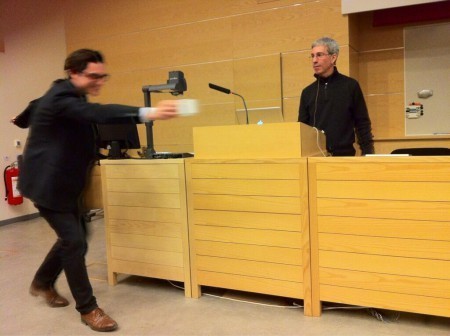Marc Abrahams's Blog, page 344
February 28, 2015
Miss Poland’s Attractiveness: What, oh, what is enough?
Leszek Pokrywka, co-author of the seminal study “The Second to Fourth Digit Ratio and Age at First Marriage in Semi-Nomadic People from Namibia” [featured here a while ago], also played a leading role in analyzing what makes and what does not make Miss Poland attractive:
“Body mass index and waist: hip ratio are not enough to characterise female attractiveness,” Leszek Pokrywka, Milan Čabrić, Helena Krakowiak, Perception, 2006;35(12):1693-7. the authors explain:
“The assessment of characteristic body features of Miss Poland beauty contest finalists compared with the control group, can contribute to recognising the contemporary ideal of beauty promoted by the mass media. The studies of Playboy models and fashion models conducted so far have been limited to the following determinants of attractiveness: body mass index, waist:hip ratio, and waist:chest ratio, which only partially describe the body shape. We compared 20 body features of the finalists of Miss Poland 2004 beauty contest with those of the students of Medical Academy in Bydgoszcz. Discriminant analysis showed that the thigh girth-height index, waist: chest ratio, height, and body mass index had the greatest discrimination power distinguishing the two groups. A model of Miss Poland finalists figure assessment is presented which allows one to distinguish super-attractive women from the control group.”

The Miss Poland contest.
BONUS: A video that addresses a question about the female attractiveness. (Thanks to investigator Lily Hashem for bringing this to our attention):
The sword swallowers and their day
Ig Nobel Prize winner Dan Meyer is the originator and prime mover behind International Sword Swallowers Day, which is today, which means that most of the world’s approximately 55 (somewhat) organized, professional sword swallowers are or will be swallowing swords in public, which is something they would do pretty much every day if they had their druthers.
The 2007 Ig Nobel Prize for Medicine was awarded to Brian Witcombe the UK, and Dan Meyer of the US, for their penetrating medical report “Sword Swallowing and Its Side Effects” (published in the British Medical Journal, December 23, 2006, vol. 333, pp. 1285-7). Here’s video of their one-minute-long acceptance speech at that year’s Ig Nobel ceremony:
Time Magazine is celebrating the day with an essay about the professionals who use large, pointed objects to practice catch-and-release fishing with themselves. The essay features Dan Meyer, and a portion of the talk Dan gave one year at the Improbable Research session at the Annual Meeting of the American Association for the Advancement of Science”
“When I put the sword in my mouth, I will repress the gag reflex in the back of the throat. Then I have to go behind my Adam’s apple, my prominentia laryngea, behind the voice box, the larynx, down about through the crichopharyngeal sphincter, up in the upper part of the mouth here. Then down into the esophagus, repress the peristalsis reflex, [muscular contractions] that swallow your food. From there relax the esophageal muscles, relax the lower esophageal sphincter, and slip the blade down into my stomach, repress the wretch reflex in my stomach.”
BONUS FACT: Dan Meyer and his sword will stage a triumphant return appearance at this year’s Ig Nobel Prize Ceremony — the 25th First Annual Ig Nobel Prize Ceremony — on September 17, 2015, at Harvard University.
February 27, 2015
Not quite Artificial Intelligence: the mating of junk + mail
The Huffington Post reports another misstep on the road to Artificial Intelligence: “Man Who Tried To Have Sex With Mailbox Found Dead“.
(TECHNICAL NOTE: This male-on-mail sex where one participant is alive and the other is not, does not qualify as homosexual necrophilia.)
Here’s a medical journal report about a similar, perhaps simpler attempt, 28 years earlier, by a different investigator:
“A case of incarceration of the penis” [article in Japanese], M. Kamizuru, T. Nakatani, M. Maekawa, M. Asakawa, R. Yasumoto, and Kiyo Hinyokika, Acta Urologica Japonica, vol. 34, no. 3, March 1988, pp. 514–6.
The author, at the Department of Urology, Osaka City University Medical School, reports: “A 38-year-old male patient had been suffering from incarceration of penis with a milk-bottle for about seventeen hours. It was successfully removed by means of a glass cutter and hammer without any complication. Fifty-seven Japanese cases of this entity including our case were reviewed and discussed.”
Czech managers have trouble with shoes, reports Gullová
 The Central European Business Review (CEBR) is a scholarly peer-reviewed journal focused on strategic business issues with a Central European perspective. For an example of a paper reflecting this remit, see an article which the CEBR published in the inaugural issue – Flaws in the Social Manners of Czech Managers.
The Central European Business Review (CEBR) is a scholarly peer-reviewed journal focused on strategic business issues with a Central European perspective. For an example of a paper reflecting this remit, see an article which the CEBR published in the inaugural issue – Flaws in the Social Manners of Czech Managers.
It’s authored by professor Ing. Soňa Gullová, Ph.D. who is a Lecturer in the Faculty of International Relations, at the University of Economics, Prague, Czech Republic. Her paper points out that “[…] many Czech managers are ignorant of the rules of their own etiquette.“
Improvements can be made though. Some tips from the paper :
“A suit also doesn’t look its best with stuffed pockets or if the trousers are too short or too long. Czechs have trouble with shoes. Shoes to go with a suit must be made of leather, have a thin sole and always be of a darker shade than the suit itself.”
“Nowadays, we do not have to finish our meal anywhere in the world; in some countries this is actually never the case as we would be signaling to the host that we have not had enough. In Europe we consider loud eructation after a meal rude; however, in many Asian countries, it is considered a tribute to the host.”
“Some of the most frequent ‘faux pas’ in the area of attire committed by Czech manages are, for example, wearing of slippers at the workplace, wearing of men’s sandals without socks with a suit, unbuttoned top buttons of a shirt together with a loosened tie etc. The hands are not to be placed in the pockets. Chewing gum is inadmissible during meetings. The most criticized issue is the blowing of one’s nose, in which case it is necessary to leave the room.”
February 26, 2015
How to prepare a mousetrap fission demonstration
The Harvard Natural Sciences Lecture Demonstrations and Snow Removal Team is seen, in this video, preparing a classic mousetrap-as-analog demonstration of how nuclear fission proceeds.
Their includes these comments:
We’ve got the set-up time down to 15 minutes, and like all nuclear devices, you only get one shot at this one.
The mouse trap chain reaction originated (we think) from Walt Disney’s 1950s film “Our Friend the Atom.”
J. Higbie (see Reference) has described a “better” mousetrap nuclear chain reaction but we prefer the old fashioned way. Setting up the last few traps while the students await the lecture to begin, dripping brow and shaking hands, certainly adds some drama. We think Enrico Fermi would agree.
Reference: J. Higbie: Am. J. Phys. 48 (1), 62 (1980)
Mouse traps are 10cm × 5cm in size, manufactured by Woodstream Corp., Lititz, PA or d-Con Corp., Montvale, NJ. Both are available in hardware stores.
Here is “Our Friend the Atom”:
(Thanks to Bob Kirshner for alerting us to this.)
NOTE: The idea may have originated ten years before the Disney film (which was released, on television, in 1957). See this paper, if you can get a copy of it:
Richard M. Sutton, A Mousetrap Atomic Bomb, AJP 15, 427-428, (1947)
Demonstration of the physics of sheep through a bottleneck
A physics experiment of sheep passing through a bottleneck, which we featured some months ago, has now been formally published, and the researchers have released a video of the experiment. The study is:
“Flow and clogging of a sheep herd passing through a bottleneck,” A. Garcimartín, J. M. Pastor, L. M. Ferrer, J. J. Ramos, C. Martín-Gómez, and I. Zuriguel, Physical Review E, vol. 91, no. 022808, 2015. (Thanks to Mason Porter and Ho-Kei Chan for bringing this to our attention.) The authors, at la Universidad de Navarra, Pamplona, report:
We present an experimental study of a flock passing through a narrow door. Video monitoring of daily routines in a farm has enabled us to collect a sizable amount of data. By measuring the time lapse between the passage of consecutive animals, some features of the flow regime can be assessed. A quantitative definition of clogging is demonstrated based on the passage time statistics. These display broad tails, which can be fitted by power laws with a relatively large exponent. On the other hand, the distribution of burst sizes robustly evidences exponential behavior. Finally, borrowing concepts from granular physics and statistical mechanics, we evaluate the effect of increasing the door size and the performance of an obstacle placed in front of it. The success of these techniques opens new possibilities regarding their eventual extension to the management of human crowds.
Here’s the video:
Magazine: The special TEETH issue is out
 The special Teeth issue (vol. 21, no. 1) of the magazine (the Annals of Improbable Research) is now out!
The special Teeth issue (vol. 21, no. 1) of the magazine (the Annals of Improbable Research) is now out!
Articles include:
“Journeys of Toothbrushes“
“Improbable Research Review“
“Improbable Sex“
…and more, more, more, including new helpings of “Improbable Medical Review”, “Boys Will Be Boys”, “Soft Is Hard”, and other outstandingly improbable research snippets from many fields and countries.
We encourage you to subscribe.
Mel (right) says it’s swell.
February 25, 2015
The formal advance of the research on beer-vs-coffee spilling
 The research on why foamy liquid (such as beer or latte) is less likely to slosh out of a cup than non-foamy liquid (such as black coffee), has now been formally published. The study is:
The research on why foamy liquid (such as beer or latte) is less likely to slosh out of a cup than non-foamy liquid (such as black coffee), has now been formally published. The study is:
“Damping of liquid sloshing by foams,” A. Sauret, F. Boulogne, J. Cappello, Emilie Dressaire [pictured here] and H.A. Stone, Physics of Fluids, vol. 27, 022103 (2015).
The slosh team presented their work in public a few months ago, at the Annual Meeting of the APS Division of Fluid Dynamics.
A few years, earlier, that annual meeting went gaga, to a very limited degree, for a research presentation about why a cup of coffee is so very easy to spill (or, looked at from the other direction, why it’s so difficult to NOT spill a cup of coffee). That coffee-spill research was eventually honored with the 2012 Ig Nobel Prize for fluid dynamics. Here’s the Ig Nobel citation for that prize:
Rouslan Krechetnikov and Hans Mayer for studying the dynamics of liquid-sloshing, to learn what happens when a person walks while carrying a cup of coffee.
REFERENCE: “Walking With Coffee: Why Does It Spill?” Hans C. Mayer and Rouslan Krechetnikov, Physical Review E, vol. 85, 2012.
In 2013, that coffee-spill research was the subject of a dramatic demonstration by Karolinska neuroscientist Gustav Nilsonne, at the Karolinska Institute in Stockholm. Here is an action photo from that demonstration:
A month from now, Gustav Nilsonne will perhaps repeat that demonstration, with both coffee and beer, when the 2015 Ig Nobel Eurotour descends on the Karolinka Institute, on Monday afternoon, March 30. (There will be a second show in Stockholm, at Boulevardteatern, in the evening.)
(Thanks to investigator Mason Porter for bringing this to our attention.)
Camp vs. Kitsch: music investigations
For those unsure about the sometimes-misunderstood difference between ‘Kitsch’ and ‘Camp’, Dr. Freya Jarman, who is a Senior Lecturer in the School of Music at the University of Liverpool, UK, provides a concise definition :
“Camp enjoys and glorifies its own awfulness where kitsch doesn‘t realise it.”
Dr. Jarman researches how ‘camp’ works, musically. See, for example: ‘Notes on Musical Camp’, in: The Ashgate Research Companion to Popular Musicology, ed. Derek B. Scott. (Burlington, VT: Ashgate Publishing, 2009), 189-203, which cites this 1969 performance by (the late) Liberace :
Unfortunately, another reference-video cited in the paper, Charlotte Church – Don’t Rain On My Parade appears to be damaged, so instead, with the definition above in mind . . .
Here is an Improbable mini-cornucopia of possible camp / kitsch renditions which might serve as a starting point for comparisons along the lines of – Camp? Kitsch? Neither? Both?
● Deee-Lite – Groove Is In The Heart
● Queen – I Want To Break Free
● Cliff Richard – Bachelor Boy
● Pet Shop Boys – Go West
● Rammstein – Seemann
● The Bonzo Dog Doo Dah Band – Canyons Of Your Mind
● Boney M – Daddy Cool
● Bee Gees – Stayin’ Alive
● Lang Lang – Schubert Standchen (Serenade)
● Mick Jagger & David Bowie – Dancing In The Street
● Robbie Williams – You Know Me
● Kenneth Williams – The Marrow Song (Oh! What a Beauty!)
● Katy Perry – California Gurls (featuring Snoop Dogg)
February 24, 2015
The ten-percenters: The hot, hot men who pinch copper
For young and youngish men of a certain disposition (regarding copper), these are exciting times, as this medical report attests.
The report is: “Electrical burn injuries secondary to copper theft,” J.A. Dunne, D. J. Wilks, D.P. Mather, and J.M. Rawlins, European Journal of Trauma and Emergency Surgery, epub 2015. The authors, at St George’s Hospital, London, Leeds General Infirmary, Pinderfields Hospital, Wakefield, and Royal Perth Hospital, Perth, Australia, report:
We would like to highlight copper theft as an international cause for high voltage electrical injury, with an illustration of cases over a 5-year period from the Yorkshire regional burns unit in the United Kingdom (UK)….
Copper price has risen dramatically in recent years, with a six-fold increase over the past decade and a large demand from booming economies such as China. Metal theft is one of the fastest rising crimes in the UK…
The risk of burns in this activity is significant, and may account for up to 10% of electrical burns presenting to a regional unit…
All cases were males, aged 22, 25 and 42 years, sustaining burns of 32, 45 and 16.5 % total body surface area (TBSA), respectively. All patients survived, and there was a mean length of stay of 47 days (range 32–59) and all patients were involved in theft from 11,000 V electrical substations.
(Thanks to investigator Adrian Smith for bringing this to our attention.)
Here’s a video news report of a case of possible copper theft in a different country:
Marc Abrahams's Blog
- Marc Abrahams's profile
- 14 followers





